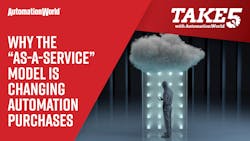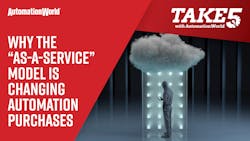Why the “As-a-Service” Model is Changing Automation Technology Purchases

Quick hits:
- Pay small monthly or annual fees for technology instead of large sums upfront.
- The as-a-service model enables manufacturers to tie their production goals to what they pay technology suppliers.
- Ensure uptime by having the supplier be responsible for maintenance and upgrades.
- By removing the upfront capital cost of investing in automation service, manufacturers can more easily try new things with lower risk.
- Machines delivered as a service tend have greater amounts of innovative capabilities built-in.
Related to this episode:
Automation World's feature story on how robotics-as-a-service is gaining traction as companies gravitate to a model that minimizes upfront capital investment, streamlines maintenance, and unleashes data-driven insights.I'm David Greenfield, director of content at Automation World. Thanks for joining me for this Take Five with Automation World episode, where I'll be highlighting an interesting development in automation hardware and software. What I'm referring to here is the growing interest in, and acceptance of, software- and machines-as-a-service.
Now, if you're not familiar yet with the as-a-service business model, what it essentially means is that rather than purchasing a particular product outright, and maintaining and upgrading it yourself, instead you pay a monthly or annual fee for access to that technology. And in that case, the provider handles all the maintenance and upgrades to ensure you're running the most up-to-date version of that technology.
Now, you're probably well aware of the software-as-a-service model, which is often referred to as SaaS. You may very well already be using it in your plant for one or more of the software applications used to run your production operations. I say this because nearly every provider of production software, from SCADA to MES to ERP, offer a cloud-based as-a-service version of their software.
In an interview with Keith Chambers—who's the vice president of operations management software at Aveva—about this trend, he said that SaaS offerings are gaining in popularity because they promise a lower total cost of ownership, a faster time to value for the user, and flexible consumption based on a company's needs.
For example, a cloud-based SaaS application allows small and medium manufacturers to more easily deploy industrial internet of things applications, such as performance management and data-driven continuous improvement tools. This gives these manufacturers the ability to scale software functionality up or down, according to their functional business needs. Bruce Kane, the global life sciences technical industry consultant at Rockwell Automation, said they're seeing a cross interest in SaaS across the board in manufacturing, because it removes the upfront capital costs of investing in full automation service, which allows manufacturers to try new things with lower risk.
Now, getting back to this as-a-service trend, it's important to realize that SaaS isn't where that as-a-service model begins and ends. The machines-as-a-service model is gaining ground too, especially in batch manufacturing. Though it's not entirely cloud-based as SaaS is, the machines-as-a-service model is something of a hybrid approach, in that it involves physical equipment—but that equipment is connected to the internet for technical updates, as well as for remote diagnostics, and even repairs by the manufacturer of that equipment.
Mark Ruberg, who's the packaging industry manager at Beckhoff Automation, said this trend around machines-as-a-service incentivizes OEMs to guarantee high performance and throughput by loading their machines with innovative features, including integrated safety, vision, mechatronics, and really many of the technologies that are really driving the digital transformation of industry.
Now, Ruberg added that he thinks this trend around machines as a service has been increasing due to the growing use of remote access and monitoring technologies in industry, particularly in the consumer packaged goods industry. He said that previously, OEMs might have scaled back capabilities to keep their machine prices competitive, but now a monthly contract makes it less of an issue. And more importantly, if the machine stops, so does the OEM's revenue stream.
So since this machines-as-a-service model aligns the machine builders' goals with the CPG manufacturers' production goals, Ruberg said that Beckhoff expects OEMs offering machines-as-a-service to become far more common in the near future. He said that some of Beckhoff's OEM customers serving the CPG industry are already seeing great success from machines-as-a-service pilot projects that have helped manufacturers achieve greater uptime and throughput.
And you can read more about this as a service trend at this link. So I hope you enjoyed this Take Five with Automation World episode, and remember to keep watching this space for new episodes coming each week to help keep you on top of the latest developments in the world of industrial automation.
